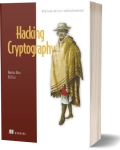Hacking Cryptography
Cybersecurity
Book Details
Book Title
Hacking Cryptography
Author
Kamran Khan and Bill Cox
Publisher
Manning Publications Co.
Publication Date
2025
ISBN
9781633439740
Number of Pages
758
Language
English
Format
File Size
7.2MB
Subject
Hacking
Table of Contents
- Copyright
- Dedication
- Contents
- Preface
- Acknowledgments
- About this book
- About the authors
- About the cover illustration
- Chapter 1. Introduction
- 1.1 What is cryptography?
- 1.2 How does cryptography work?
- 1.3 Attacks on cryptographic theory vs. attacks on implementations
- 1.4 What will you learn in this book?
- Chapter 2. Random number generators
- 2.1 Why do we need random numbers for cryptography?
- 2.2 Understanding different types of RNGs
- Chapter 3. Implementing and exploiting RNGs
- 3.1 Implementing and exploiting Mersenne Twister-based RNGs
- 3.2 Implementing and exploiting the Dual Elliptic Curve Deterministic Random Bit Generator
- Chapter 4. Stream ciphers
- 4.1 Symmetric key encryption
- 4.2 Linear feedback shift registers (LFSRs)
- 4.3 RC4 encryption and Wi-Fi security
- Chapter 5. Block ciphers
- 5.1 Important block ciphers
- 5.2 Padding: Making data fit blocks neatly
- 5.3 Modes of operation for block ciphers
- 5.4 Padding oracles and how to attack them
- 5.5 Browser Exploit Against SSL/TLS: The BEAST attack
- Chapter 6. Hash functions
- 6.1 Hash functions as one-way digital fingerprints
- 6.2 Security properties of hash functions
- 6.3 Important hash functions
- 6.4 Attacks on hash functions
- Chapter 7. Message authentication codes
- 7.1 Message integrity and authenticity
- 7.2 Different types of MACs
- 7.3 Secret-prefix MACs and length-extension attacks
- 7.4 Secret-suffix MACs and collision attacks
- 7.5 HMACs: Hash-based MACs
- Chapter 8. Public-key cryptography
- 8.1 Asymmetric cryptography: Splitting the secret key into public and private portions
- 8.2 Mathematical theory behind public-key cryptography
- 8.3 Types of public-key cryptography systems
- 8.4 Exploiting RSA
- Chapter 9. Digital signatures
- 9.1 Message authenticity using symmetric and asymmetric secrets
- 9.2 Practical applications of digital signatures
- 9.3 Forgery attacks on digital signatures
- 9.4 Schoolbook RSA signatures
- 9.5 The elliptic curve digital signature algorithm (ECDSA)
- 9.6 RSA signature forgery with Bleichenbacher’s e = 3 attack
- Chapter 10. Guidelines and common pitfalls for cryptographic implementations
